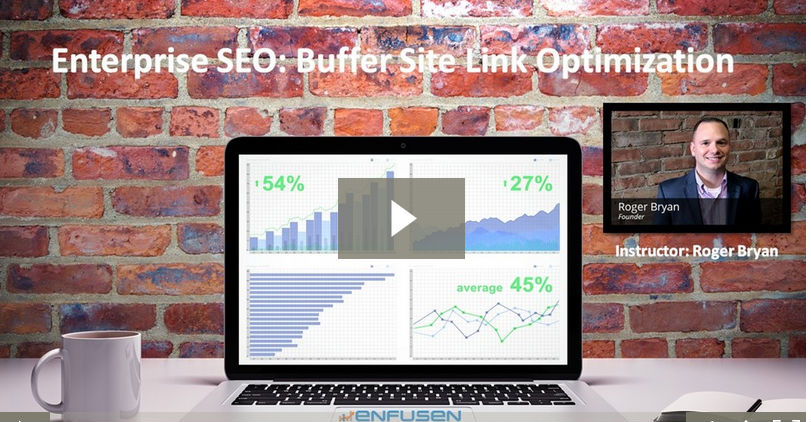
In this training video, Enfusen Founder Roger Bryan explains how to apply the different types of link-building SEO strategies on buffer sites, such as Tumblr, that can help increase the rank of your organization’s website.
Highlights
2:14 How many links to use in a post
3:17 How many words to use in a post
4:07 Whether or not to include an image
4:18 How to use different types of anchor text
9:30 Where to link to
10:08 How to use different URL structure styles
Transcription
Hi, this is Roger from Enfusen. In this video I’m going to be talking about link building best practices from a buffer perspective and how you actually do link building inside of the posts that you make. One of the buffers that we really like to use is Tumblr. When I say buffer typically what we’re talking about are websites where we can post high quality original content that links back to a site that we’re trying to rank. We create hundreds if not thousands of these for each client, they’re all done manually by hand, we use no automated tools. Part of this is that when you have your writers going out and creating the content to put on here, they need to know the right strategy. In a previous video I outlined all of the different link building types, now we’re going to do some practical application of this. The reason that I picked this post is because it was not done correctly, and it definitely needs to be updated so let’s take a look at this.
I can tell that the content, the keyword that we’re trying to rank for, is going to be content marketing analytics. I can tell that because this is the page on our website that we were working on for this sample in order to get our stuff to rank well. It’s really important to know exactly what you’re working on. When we start to work on this, we’re going to start to look at how the keywords were used in the copy, and what links were used in order to link back to us.
We’re going to start with a few rules. These are not absolutes, these are rules we use to make sure that we’ve got a good probability of ranking well while creating zero risk for the campaigns that we’re working on. Most people would never be able to tell that any type of SEO is being done for any of our clients websites because we follow these rules.
What are some of these rules? I put them over here on the right so you can follow along as we do this.
Links
The first one we want to talk about is you don’t really want to put more than three links in a post. In fact, you don’t always have to use three. As it says right here, sometimes you can use three, sometimes you can use two, sometimes you can use one. A lot of times we actually make posts with no links in them whatsoever. We don’t want every single post to go out on one of our blogs to have a link in it because it doesn’t look natural, not very piece of content that’s created has a link in it.
The next part of this that we’re going to look at it is that there’s a couple different types of links. We like to have one anchor text, which is something like this, this is a keyword that when you click on it, takes you over to the website that it’s linking to. That’s an anchor text. A naked text is the full use of the actual URL, like down here which I got from right here. Now you’re going to see that one of the problems with this post is, it’s not using any naked links. Right now it’s using three different anchor text links which is definitely not a best practice, so we’re going to fix that in a minute.
Word count
We’re also going to look that it has a minimum of three hundred and fifty words, and I don’t know if Tumblr has a word count tool so let me go like this, oops. Sorry, that last piece is a link that’s making it hard to copy. I’m going to copy this, and I’m just going to open up Word real quick, hold on, it’s opening up on another screen. At least it’s trying to, there we go. I want to see how many words we have. Three hundred and sixty words, so of course this writer is doing the bare minimum and just trying to get on our minimum threshold. I would like them to always be five hundred words or more.
Images
Does it have an image? Yes, it has an image. Some sites allow you to do better jobs with file names, image alt tags, and different things like that, which we’ll look at in a minute.
Different anchor types
There are a couple different types of anchor text that you can use.
This is an anchor text that’s an exact match. We said that our keyword is content marketing analytics, I can actually put that up here, so we know exactly what we’re working with. It’s okay to do this every once in a while, you do want to have that variety, or that link density so that not everything looks exactly the same. Now I’m going to scroll down and I’m going to see that content analytics, that’s actually pretty similar. I don’t know that it’s going to qualify as the rest of these, so what are some of the other types that you can have?
Phrase match, if exact match is content marketing analytics, phrase match can be, what is content marketing analytics? Typically in phrase match we say that it has a prefix if some type, or a suffix of some type that you actually put into the link. Let’s see here, I am in, if you want to invest in … now I can see, I’m going to remove this link, and I could do, copy this in, now I’ve changed that into a phrase match. Now I’m not going to save that because we’re still violating a couple different rules here that we need to fix.
The next type is synonym match, and that is changing the keywords up enough that they’re similar from a context perspective but they’re completely different words. For a good example here is content marketing analytics could be blog post analytics, content in blog posts are very similar so they can be swapped out. This allows us to get a wider reach of keywords while still getting the credit for being on topic.
The next is sentence match, content marketing analytics is a great way to tell how your content is performing. I could do something like, I could highlight all of this and turn it all into the link, and now we have sentence match, that’s great.
Random match is just picking a random word, or different thinks like, click here, or read more. I could come down to the end of this and put something, if you would like to learn more about content marketing analytics please visit our site, click here. I could highlight this, turn it into a link, and click done. Now that’s a random link.
Now one of the problems that this post has besides using the same type of links is it doesn’t have any anchor text. I want to get an anchor text link in here because if every link on your page is an anchor, you can get found. I want a naked link, so let’s take this one here, now I can click right here, and I’m actually going to put this link in here. Now, the nice thing is that it automatically links it, so now I actually have a naked link in here, which is good. I’ve got my keyword anchor text in the first paragraph linking over to my page, I come down here, I’ve got an anchor text … sorry, a naked link to the same page.
Now I really only want one more link, now let’s look where this one is linking. I think I already have this up, so this is something that can be done every once in a while in order to give yourself credibility. Search engine optimization is actually linking out to search engine land. That’s not a bad thing, that gives you an opportunity to link to a high authority site. Now it doesn’t give you much credit, it’s not like a link coming back to you, but it says that, “Hey, not every link on this page is going to the exact same website, I’m actually linking out to a third party website,” and not only that, it’s a high reputable site and it’s definitely on topic.
I would say that search engine optimization and content marketing analytics probably are not in alignment with each other, so that would violate a rule from having congruence in the overall strategy. First thing I’m going to do is I am going to break this link, okay. Now that links gone because I don’t think that’s a good link. We have an anchor text, now you don’t have to use an anchor text every time. In fact I’m going to say don’t use every time. You do usually want to have at least one of these four with a keyword, either exact match phrase, synonym, or sentence, but you don’t want to use the same one every single time. We’ve got our anchor text to our landing page, we’ve got a naked to our landing page, so this is where we have to look at the next thing. Where do you link to?
Where to link to
You can link to the page that you’re trying to rank for, you could link to a homepage, you can link to a landing page, or sales page, you can link to a resource page if you use those, you can link to an image on your website if you’re trying to get that to rank, or you can link to a third party authority site. I had already shown you that one of the links was to a third party authority site, what I want to do now is I want to change this link here and I actually just want to link to our homepage. You want to have links going to a lot of different places on your website as it says over here.
Different URL structure types
One last thing to consider when you’re doing your link building from a buffer site or a third party content site is that you want to use different URL structures and these are just a couple different types. A good example here is, this says HTTP. This has just WWW, this does not have any of those. Now you need to make sure that your website is properly setup with the correct canonicals, and redirect so that all of these would work. I want to mix it up a little bit, so this is using, let’s inspect this, it is using the full HTTP and WWW. I’m going to come down here, I’m going to look at this one. This might actually be the easiest thing for me to change, I am just going to get rid of the HTTP so that it is going to our website, but without the HTTP. It’s all going to get to the same place if everything’s setup correctly on your website, but it’s going to give a little bit of variety.
Review
As a review for this we do have an anchor text, that anchor text is going to the page we’re trying to rank. We’re going to go down here, we have another link, this is what we’re going to call either phrase or sentence match because it’s a longer term, it does still have the keyword in it. This time I’m going to go to the homepage of our website, as you can see right here. Then down in this last one I’m going to link with a naked link back to our website and just switch up the HTTP. Now, I could make this a third place. We’ve got a page we’re trying to rank, we have a homepage, I could put this to an image, I could do it to a variety of different things. For this I’m going to do it like this. I’m going to click save, we can get rid of this now.
This is a well optimized page. Now, I could say it could use a couple more keywords … or I’m sorry, it could use a couple more words overall, Tumblr I actually looked when it comes to inspecting the element for the image optimization, they actually give a number to this. I’m not even going to worry about that, it’s not a bad idea to link if it will let you. Let me go back to edit, let me try one thing. Yeah, no, it doesn’t really let me do much with the image once it’s uploaded. Postdate rich text, okay. That’s really it for this video. These are the link building best practices when you go in.
Now, we have a tool that kind of shows us density across the content that we create to make this easier. If you’re working, say off of an Excel spreadsheet, or a Google Doc and trying to keep track of all the content that you’re doing external to your website it’s a good idea to maybe create some columns and maybe keep track of maybe every ten looking to see that there’s some variety, so that as you do more and more of this that you’re getting the best opportunity to rank with the least amount of risk.
End result: high-quality content
This content piece here is one hundred percent original, hand written. It’s a legitimate blog, the blog is optimized, it has purpose, it has calls to action in it. This is what the world wants, it wants high quality content. If you read this, you would learn something. If you decided to click you would get over to learn more. It’s not about doing spammy links, or spammy content, this is real legit content that we’re doing that provides real value.
We’re mixing it up, we’re doing zero, one, two, or three links. Typically never more, unless we get into a two thousand plus word post, we might have an opportunity to do more. We’re using a combination of anchors and nakeds. When we look at the different types of anchors, exact match, phrase match, synonym match, sentence match, random match.
We’re also mixing up where we link. The page we’re trying to rank, a homepage, a landing page, or sales page, a resource page, an image, maybe a third party authority site. You know what, I could actually ad in here too which isn’t a bad idea, you can link to your social media profiles.
There’s a couple different ways to structure a URL, and there’s actually more than this, but this is just the simplest way to do it is using the HTTP, not using it, and then not even using the WWW. Again, making sure that everything’s setup correctly on your website to be able to handle that.
This is Roger from Enfusen, and this is a video on how to do link building when you’re doing buffer sites, thank you.

